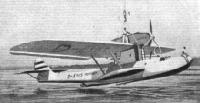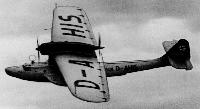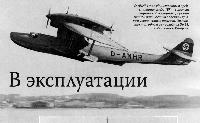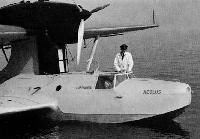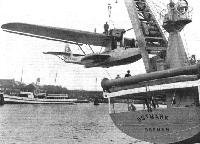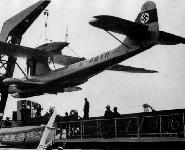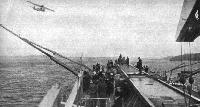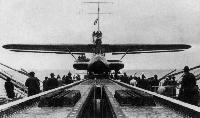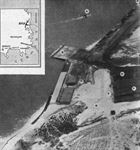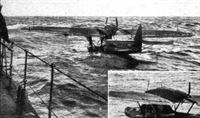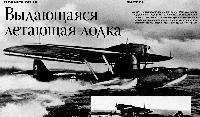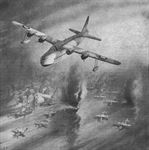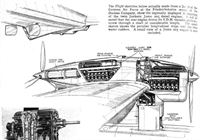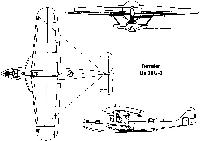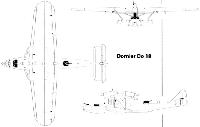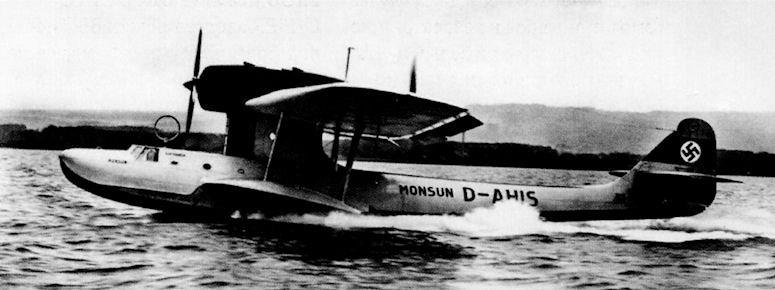
Описание
Страна : Германия
Год : 1935
Летающая лодка
Прибрежная разведывательная летающая лодка с экипажем из четырех человек
Do.18
Летающая лодка, цельнометаллический моноплан-парасоль. Два мотора установлены тандемом на крыле. Спроектирована в КБ "Дорнье верке" под руководством К. Дорнье. Первый полет опытного почтового гидросамолета Do 18а состоялся 15 марта 1935 г. Военный вариант Do 18d вышел на испытания в конце 1935 г. Серийное производство развернули летом 1936 г. Лодка строилась на заводах "Дорнье" (Фридрихсгафен) и "Везер флюгцойгбау" (Эйнсварден, Норденхам). Всего изготовлено около 160 экз. (включая гражданские машины).
Экипаж - 4 чел. Двигатели и вооружение - в зависимости от модификации.
Do 18 состоял на вооружении в Германии с лета 1936 г.
Выпускался в следующих военных модификациях:
- Do 18D с моторами Jumo 205C, вооружение 2x7,9, бомбы до 100 кг;
- Do 18G с моторами Jumo 205D, вооружение 1x20+1x13, предусмотрены стартовые ускорители;
- Do 18N, переделка Do 18D в спасательный самолет.
Массовое поступление Do 18 в береговые группы Люфтваффе началось с 1938 г. Летающие лодки этого типа участвовали в боевых операциях с самого начала Второй мировой войны. Еще перед началом войны они приступили к систематическому патрулированию Северного моря. Как разведчики действовали против Польши и во время Норвежской кампании. В последней их использовали и как транспортные самолеты для доставки людей и грузов на побережье Норвегии. С октября 1940 г. Do 18 начали применяться как спасательные в Ла-Манше. С августа 1941 г. использовались только в спасательных подразделениях, дислоцировавшихся в самой Германии, Норвегии и Франции.
Do 18 сняли с производства в августе 1940 г. До конца 1942 г. они эксплуатировались как спасательные, до мая 1944 г. как учебные в школах морской авиации.
Do 18G||
Размах:||23,7 м
Длина:||19,38 м
Моторы, количество х мощность:||2х 700 л.с.
Взлетная масса, максимальная:||10500 кг (при старте с воды, при взлете с катапульты - до 12000 кг)
Максимальная скорость:||265 км/ч
Практический потолок:||4260 м
Дальность:||3200 км
Описание:
- Do.18
- Dornier Do 18
- Flight, October 1936
REPLACING THE WAL - Flight, November 1939
THE DORNIER FLYING BOATS
Фотографии
-
Авиация и Космонавтика 1996-11 / ??? - Самолеты Люфтваффе (9)
Do 18D 2/Ku.Fl.Gr.406 (Лето 1938 года)
-
In Action 1008 / Luftwaffe in Action 4 (4)
Dornier Do 18D-1 of 2./Ku.Fl.Gr. 506 (1941)
-
Air International 1980-04 / Model enthusiast
Do 18D of 2./Ku.Fl.Gr.506, Spring 1939
-
Мировая Авиация 243
Do 18D поступил на вооружение Люфтваффе в 1938 году. Данная машина в августе 1939 года принадлежала 3-й эскадрилье 406-й разведывательной группы (3./Ku.Fl. Gr.406), дислоцировавшейся в германском Хёрнуме. Хорошо видны открытые стрелковые точки.
-
Мировая Авиация 82
Do 18D-1, окрашенный по схеме 1939 года. Самолеты этого типа использовались в Люфтваффе для разведки и нанесения ударов на Северном море и у берегов Норвегии в 1939 году и в начале 1940 года.
-
Air International 1980-04 / Model enthusiast
Do 18D of FFS (See), Summer 1939.
-
Мировая Авиация 117
Do 18D-1 из морской Школы транспортной авиации в окраске 1939 года. Do 18D-1 использовался в 1939 - начале 1940 годов для ведения разведки и нарушения судоходства в Северном море и у берегов Норвегии.
-
Air International 1980-04 / Model enthusiast
Do 18D of 2./Ku.Fl.Gr.906 at Kamp/Pomerania, Winter 1939-40.
-
Мировая Авиация 250
Do 18D из эскадрильи 2./Ku.Fl.Gr 906, зимой 1939-1940 годов, накануне кампании в Норвегии, это подразделение базировалось в Хёрнуме на Фризских островах. Эмблема эскадрильи в виде трех рыб нанесена в передней части мотогондолы. На верхнюю поверхность крыла нанесены стандартные опознавательные знаки в виде крестов и индивидуальное обозначение самолета («C» красного цвета), а также огромный крест белого цвета как знак быстрого опознавания.
-
Air International 1980-04 / Model enthusiast
Do 18D of 3./Ku.Fl.Gr.406 at List (Sylt), August 1939
-
Мировая Авиация 250
Разведчик/поисково-спасательный Do 18D (K6+HL) из 3./Ku.Fl.Gr.406. Перенумерованная в 2,/Ku.Fl.Gr.306, эскадрилья действовала в Северном море с различных баз, в том числе и норвежских.
-
Air International 1980-04 / Model enthusiast
Do 18G of 6.Seenotstaffel, Central Mediterranean, 1941-42.
-
Мировая Авиация 110
Поисково-спасательная летающая лодка Do 18G-1 из 6,/Seenotstaffel, центральное Средиземноморье, 1941-1942 года.
-
Мировая Авиация 250
Поисково-спасательный Do 18G-1 u3 6.Seenotstaffel Люфтваффе, эскадрилья в 1941-1942 годах действовала на Средиземном море. На Средиземноморье Do 18G-1 зарекомендовал себя удачной поисково-спасательной летающей лодкой, пусть и не столь эффективной, как ее британские аналоги.
-
Мировая Авиация 117
Регистрационный номер: D-AHIS [6] Оснащенная двигателями Jumo 5C лодка Do 18а (D-AHIS Monsun) рулит по водной глади Боденского озера, также именуемого озеро Констанц. Самолет разбился на Балтике в ноябре 1935 года в ходе летных испытаний.
The Jumo 5C-engined Do 18a D-AHIS Monsun taxying at speed on Lake Constance. -
Aeroplane Monthly 1988-06 / J.Stroud - Wings of Peace
Регистрационный номер: D-AHIS [6] D-AHIS Monsun, the first of the Dornier Do 18s, first flew on March 15, 1935.
-
Flight 1935-11 / Flight
Регистрационный номер: D-AHIS [6] FOR THE SOUTH ATLANTIC: The latest Dornier flying boat for the D.L.H. mail service photographed on Lake Constance. This machine, which has Diesel engines, cruises at 124 m.p.h. and has a range of 2,485 miles.
-
Flight 1935-11 / Flight
Регистрационный номер: D-AHIS [6] Two Junkers Jumo compression-ignition engines are fitted to this new Dornier Do.18, which is intended for the South Atlantic service.
-
Flight 1936-01 / Flight
Регистрационный номер: D-AHIS [6] FOR SOUTHERN SERVICE: The Monsun, first of the Dornier Do. 18 boats for the German South Atlantic mail service. A range of 2,765 miles is claimed at a cruising speed of 124 m.p.h. Two 500/560 h.p. Junkers Jumo diesels are fitted, the rear one driving its propeller through shafting.
-
Мировая Авиация 117
Регистрационный номер: D-AHIS [6] Регистрацию D-AHIS имел первый прототип Do 18а. Элероны и закрылки занимают почти всю заднюю кромку крыла.
-
Aeroplane Monthly 1988-06 / J.Stroud - Wings of Peace
Регистрационный номер: D-ANHR [5] D-ANHR was the only big-wing Do 18F. It was re-engined with BMW 132Ns as the Do 18L.
-
Мировая Авиация 243
Регистрационный номер: D-ANHR [5] D-ANHR стал единственным представителем Do 18F - самолет специальной постройки, с увеличенной дальностью полета и крылом увеличенного размаха. Он также стал одним из последних Do 18, собранных в Манцеле.
D-ANHR in its original form as the Do 18F, this being a special extended-range model with an enlarged wing, and one of the last Do 18s off the Manzell assembly line. -
Jane's All the World Aircraft 1938 / 03 - All the world's aeroplanes
Регистрационный номер: D-ANHR [5] The Dornier Do.18 Long-range Flying-boat (two 500-560 h.p. Junkers "Jumo 205" heavy-oil engines).
-
Jane's All the World Aircraft 1938 / 03 - All the world's aeroplanes
Регистрационный номер: D-ANHR [5] Another view of the Dornier Do.18 showing the mounting of the Junkers engines.
-
Aeroplane Monthly 1988-06 / J.Stroud - Wings of Peace
Регистрационный номер: D-AANE Do 18E D-AANE Zyklon was a converted Dornier Do 18D.
-
Air Enthusiast 2001-01 / T.Singfield - The Free Air of Heaven
Регистрационный номер: D-ABYM [8] Moored in Hamilton harbour, Do 18E D-ABYM 'Aeolus' was one of two Lufthansa Dorniers that passed through Bermuda on survey flights from Lisbon to New York in 1936.
-
Мировая Авиация 117
Регистрационный номер: D-ABYM [8] FIRST ACROSS: Last week a D.L.H. Dornier Do.18 made what may be called the first experimental commercial crossing of the North Atlantic after being catapulted from the Schwabenland, which has been transferred from the South Atlantic service. The Do. 18, of course, has diesel engines and the flight is referred to in a leading article this week.
-
Air International 1980-04 / ??? - The Do 18 ... Dornier's whale calf /Warbirds/
Регистрационный номер: D-ABYM [8] The first of the Do 18s actually operated by DLH, the Do 18 V3 D-ABYM Aeolus, making a low run over Lake Constance. This aircraft flew from Horta. in the Azores, to Hamilton, Bermuda, on 11 September 1936, after a catapult launch from the Schwabenland.
-
Мировая Авиация 117
Регистрационный номер: D-ABYM [8] "Dornier" создавала Do 18 для замены Wal, первые машины получила компания "Lufthansa" (1936 год). "Aeolus" - название третьего прототипа Do 18, после испытаний в Северной Атлантике эта лодка эксплуатировалась на южноатлантических линиях.
-
Aeroplane Monthly 1988-06 / J.Stroud - Wings of Peace
Регистрационный номер: D-ABYM [8] Another view of D-ABYM before the name Aeolus was painted on the fuselage.
This view of Dornier 18E Aeolus emphasises its clean lines, greatly enhanced by the neat push-pull installation of the two 600 h.p. Jumo 205C Diesels. Three crew and four passengers were carried. -
Aeroplane Monthly 1976-04 / H.Seabrook-Smith - Lufthansa 1926-76 (1)
Регистрационный номер: D-ABYM [8] Dornier Do 18E D-ABYM Aeolus suspended from the Ostmark’s crane.
-
Flight 1936-06 / Flight
THE "OSTMARK" IN ACTION: By now the new D.L.H. catapult ship Ostmark, some plans for which were detailed in Flight of May 7, should be at Bathurst. During the week-end she made a trial trip in the Gulf of Lubeck. This picture shows a Dornier Do.18 (two 500/560 Junkers Jumo 205 diesels) being hoisted aboard.
-
Мировая Авиация 243
Регистрационный номер: D-ABYM [8] На фотографии - Do 18V3 "Aeolus". В один из дней самолет "Zephir" совершил первый полет с Азорских островов в Нью-Йорк, a "Aeolus" в тот же день отправился из Хорты в Гамильтон на Бермудах, а на следующий день - в Нью-Йорк.
-
Flight 1937-07 / Flight
Регистрационный номер: D-ABYM [8] The third Do 18, D-ABYM Aeolus, mounted on the catapult of a depot ship.
Taken at Azores on board the D.L.H. catapult ship Schwabenland (on board the mother ship Ostmark ???), this photograph of the Dornier Do.18 Aeolus (two Junkers Jumo diesels) probably gives a better idea of its hull lines than any of those previously published. Unfortunately for those interested in comparisons, the German company has been refused permission to use the Irish Free State for its North Atlantic experiments. -
Flight 1937-07 / Flight
In this picture the Do. 18 is seen circling the Ostmark after being catapulted off. The latest D.L.H. mothership Friesenland carries a catapult capable of launching aircraft up to 37,000 lb. gross weight.
-
Flight 1939-04 / Flight
A view including the Dornier Do.26 four-engined long-range flying boat (on the water) and the earlier Do.18.
Другие самолёты на фотографии: Dornier Do.26 - Германия - 1938
-
Air International 1980-04 / ??? - The Do 18 ... Dornier's whale calf /Warbirds/
A Do 18D about to be lifted aboard a seaplane tender
-
Air International 1980-04 / ??? - The Do 18 ... Dornier's whale calf /Warbirds/
A pre-production Do 18D with cut-down tail fin and braced endplate auxiliary fins, tested as an optional tail configuration to that finally adopted by the production series.
-
Мировая Авиация 243
Один из Do 18E компании DLH в готовности к пуску с катапульты тендера - применение последних позволило увеличить дальность действия коммерческих летающих лодок. Тендеры находились в Батурсте (Гамбия) и Фернандо-де-Норонья (Бразилия) и обслуживали южно-атлантический маршрут.
-
Aeroplane Monthly 1988-06 / J.Stroud - Wings of Peace
Регистрационный номер: D-ARUN [2] D-ARUN Zephir was probably converted on the production line from the first Do 18D.
-
Мировая Авиация 243
Регистрационный номер: D-ARUN [2] Этот D-ARUN "Zephir" являлся предсерийным Do 18D, но достраивался как Do 18E. Самолет за 22 часа 12 минут преодолел расстояние от Хорты на Азорских островах до Нью-Йорка. Компания DLH также получила еще три самолета, которые оснащались двигателями Jumo 6C и получили названия "Zyklon","Aeolus" и "Pampero". Do 18 имел экипаж из двух пилотов и радиста.
D-ARUN Zephir. a pre-production Do 18D completed to Do 18E standards for DLH and flown non-stop Horta-New York. -
Air International 1980-04 / ??? - The Do 18 ... Dornier's whale calf /Warbirds/
Прототип морского разведчика Do 18d во время первого этапа испытаний. Самолет стал единственным Do 18, оснащенным двухкилевым хвостовым оперением - на серийных машинах применялось однокилевое оперение. Под правой консолью крыла видны авиабомбы.
The Do 18d, the prototype of the maritime reconnaissance version of the Dornier flying boat, seen alighting during early flight trials. This was the only example of the Do 18 to feature a twin fin-and-rudder tail assembly, this being discarded in favour of a single unit by the series model. Note the bombs under the starboard wing. -
Мировая Авиация 243
Регистрационный номер: D-AJII На фотографии - предсерийный Do 18D-01. Отличительной особенностью летающих лодок фирмы "Dornier" были стабилизирующие спонсоны.
The first pre-production Do 18D (D-AJII) delivered for trials to Fliegerstaffel (F) List in 1936 -
Мировая Авиация 243
Do 18D-2 несет на капоте обозначения 2-й эскадрильи 506-й разведывательной группы (2./Ku.Fl.Gr.506). До войны группы имели три эскадрильи - 1-я и 3-я оснащались машинами малой дальности, а 2-я эскадрилья располагала самолетами дальней разведки Do 18D. Всего имелось пять таких эскадрилий.
A Do 18D-2 of 2./Ku.Fl.Gr 406 (60 + A42) displaying the "Iron Hand" Staffel emblem on the side of the forward engine cowling. -
Flight 1940-01 / Flight
List on the Island of Sylt, is a big German seaplane base as shown by this photograph taken by R.A.F. reconnaissance aircraft. The machines in front of the hangars (C and E) are mostly Heinkel He 115 floatplanes, but there appears to be one Dornier Do 18 flying boat which has two Junkers Deisel engines in tandem. From this the R.A.F. has plotted the position of the wireless station (A), hangars (B and H), cranes (D and F), barracks (J), transport sheds (L) and buildings under construction (M).
Другие самолёты на фотографии: Heinkel He-115 - Германия - 1937
-
Flight 1940-03 / Flight
A. Heinkel HE115 being towed to crane for lifting out. B. Slipway for launching. C. Curious camouflage effect. D. Do 18 flying boat. E. Large hangar. F. Disused light railway. G. Shelter trench.
Другие самолёты на фотографии: Heinkel He-115 - Германия - 1937
-
In Action 1008 / Luftwaffe in Action 4 (4)
A peaceful scene at a large German seaplane base on the North Sea coast. Some of the Dornier Do 18D-1s bear the markings and iron gauntlet insignia of Kiistenflieger Gruppe (Coastal Patrol Group) 406, while the Dornier flying boats in the foreground carry the three seagulls of the First Staffel of KuFlGr 506 on their engine cowlings. These Dorniers are armed with a single MG15 machine gun in the bow station, and another in the open middle fuselage turret.
-
In Action 1008 / Luftwaffe in Action 4 (4)
Dornier Do 18D-1s are shown here at rest, being serviced by ground personnel. The Do 18 in the foreground has been mounted on a large rubber-tired dolly, as are the other Do 18s in this photo. It is interesting to note that the personnel of the German Coastal Patrol units were taken from the ranks of both the Luftwaffe and the Kriegsmarine. Teamwork between the men of the two services was at a high standard and there was a great deal of competition among the ranks of the Luftwaffe to get assigned to one of the prestigious units.
-
Aeroplane Monthly 1987-01 / Personal album
A Dornier Do 18G-1 unobtrusively tucked away in a corner at Schleswig, June-August 1945. A closer look however, reveals FuG 200 Hohentwiel aerials on the leading edges of the wings. Only a very few Do 18s were equipped with this search radar towards the end of 1944 and it was the intention to form two units for anti-submarine work at night in the Baltic Sea. This is one of the survivors.
-
Мировая Авиация 250
Do 18G отличался от предшественников верхней турелью с гидроприводом, но гидроплан все равно остался уязвимым от атак истребителей противника. На фотографии: Do 18G-1 из подразделения 6.Seenotstaffel поднимают для установки на колесную тележку.
The definitive production version of the Dornier flying boat, the Do 18G, which featured uprated engines and more effective defensive armament. Most flying boats of this type were converted as Do 18Ns for air-sea rescue duties. -
In Action 1008 / Luftwaffe in Action 4 (4)
A rather rare photo of a dark green camouflaged Do 18D-1 flying boat of the Second Staffel of Coastal Patrol Group 306 (later part of KuFlGr 406) being wheeled back on a catapult mount on board a seaplane tender during the opening phases of the German campaigns of 1940. The Dornier Do 18D was one of the largest seaplanes to be launched from a catapult mount during WW II.
-
Jane's All the World Aircraft 1946 / 03 - All the world's aeroplanes
Do 18 сходит по слипу на воду перед взлетом с базы гидросамолетов в Германии.
The Dornier Do 18 Reconnaissance Flying-boat (two 600 h.p. Junkers Jumo 205 engines). -
Flight 1939-10 / Flight
A Dornier Do18K flying boat brought down during an attack on our Fleet.
-
Flight 1939-10 / Flight
The crew of the Do18K preparing to launch their rubber dinghy. It was a flying boat of this type which, in 1938 made a catapult-launched non-stop flight from Start Bay, Devon, to Caravellas on the coast of Brazil, a distance oi 5,220 miles. The type is fitted with two Junkers diesel engines
-
Мировая Авиация 117
Do 18D-2 на воде, 1938г.
Заказ на Do 18 от "Deutsche Lufthansa" был получен в 1934 году. На прототипе стояло два дизеля Jumo 5, первый полет состоялся 15 марта 1935 года. Четыре последующих лодки для "Lufthansa" оснащались моторами Jumo 6C и получили собственные имена "Zyklon", "Aeolus", "Pampero" и "Zephir", все они обозначались Do 18Е. Единственный построенный Do 18F отличался крылом увеличенной площади, на нем 27-29 марта 1938 года был установлен рекорд дальности беспосадочного перелета по прямой для гидросамолетов. -
Мировая Авиация 117
Do 18 - классическая летающая лодка "Dornier", с узким двухреданным корпусом, развитыми спонсонами-"жабрами" и высокорасположенным крылом, установленным на центральном пилоне и снабженным подкосами. Радиаторы двигателей размещались в пилоне крыла.
-
Мировая Авиация 250
0о 18D из эскадрильи 2./Ku.Fl.Gr.506, сформированной в Кемпе в 1939 году и вскоре перебазированной в Хёрнум. В октябре обозначение подразделения изменилось на 1./Ku.Fl.Gr.406 в связи с формированием новой эскадрильи 2./Ku.Fl.Gr.506, оснащенной самолетами He 115.
-
Flight 1939-11 / Flight
The Service type Do 18 is generally similar to the long-range aircraft built for Lufthansa. There are unprotected gun-rings in the bows and on top of the hull aft of the wing. Bombs may be carried under the outer wing panels.
-
Air International 1980-04 / ??? - The Do 18 ... Dornier's whale calf /Warbirds/
A Do 18D-3 photographed in 1940. Note the revised bow line, and the large windscreen protecting the dorsal gunner.
-
Мировая Авиация 250
Лодка Do 18D-3, отличавшаяся от Do 18D-2 обводами корпуса и козырьком перед кормовой турелью, 1940 год.
-
Flight 1940-01 / Flight
The Dornier Do 18 flying boat is the type most commonly employed by the Germans for over-water reconnaissance and patrol. It is related at the beginning of this article how one of three of these aircraft was recently shot down by a machine of the R.A.F. Coastal Command.
-
Flight 1940-05 / Flight
A Dornier Do 18 flying boat as seen from a Blenheim, which just after this picture was taken shot it down into the sea.
-
In Action 1008 / Luftwaffe in Action 4 (4)
This view shows the forward engine cowling of the Junkers Jumo 205 diesel engine on a Dornier flying boat of the Second Staffel of Coastal Patrol Group 106. The insignia on the cowling is a stylized shield with a dolphin leaping through a white-capped wave. This photo was taken in Norway during the 1940 campaign. Later in the war the unit insignia was frequently shown without the shield background.
-
Air International 1980-04 / ??? - The Do 18 ... Dornier's whale calf /Warbirds/
Регистрационный номер: D-ANHR [5] D-ANHR after rebuilding as the sole example of the Do 18L, which, flown on 21 November 1940. was powered by two BMW 132M air-cooled radials.
-
Flight 1939-11 / Flight
A small view of a Jumo 205 engine
-
Flight 1938-01 / Flight Advertisements
Dornier Do 18 equipped with Askania-Aircraft-Instruments.
-
Flight 1940-04 / Flight
A Dornier Do 18 flying boat brought down by fire from British warships.
-
Мировая Авиация 250
Несмотря на наличие у корпуса развитых спонсонов, поврежденные Do 18 не могли долго удерживаться на плаву.
-
Aeroplane Monthly 1977-02 / D.Edwards - Shoot out in cloud nine
Другие самолёты на фотографии: Lockheed Hudson A-28 / A-29 - США - 1938
-
Flight 1940-10 / Flight
OUT OF THE SUN. A Short Sunderland attacks Dornier Do.18s at moorings. German flying boats have proved no match for this formidable R.A.F. machine, which outflies and outfights them whenever contact is made.
Другие самолёты на фотографии: Short Sunderland / S.25 - Великобритания - 1937
-
Flight 1939-09 / Flight
DORNIER DO 18K. Two Junkers diesel engines give this machine an unusually long range, though the performance is quite low as indicated by the fact that the machine guns are installed on unprotected manually operated mountings.
-
Flight 1939-11 / Flight
The Flight sketches actually made from a Do 18 of the German Air Force at the Friedrichshafen works of the Dornier Company, show the ingenuity displayed in of the twin Junkers Jumo 205 diesel engines. lt will be noted that the rear engine drives its V.D.M. variable-pitch air screw through a shaft of considerable length. The small sketch shows the peculiar longitudinal steps and the twin water rudders.
-
Flight 1937-05 / Flight
Four German types in regular service fitted with Junkers Jumo compression-ignition engines.
Другие самолёты на фотографии: Junkers G 38 - Германия - 1929Junkers Ju.52/3m - Германия - 1931Junkers Ju.86 - Германия - 1934
-
Моделист-Конструктор Гидросамолеты Второй мировой войны
Dornier Do 18G-1
-
Мировая Авиация 110
Dornier Do 18
-
Air International 1980-04 / ??? - The Do 18 ... Dornier's whale calf /Warbirds/
The definitive production version of the Dornier flying boat, the Do 18G, which featured uprated engines and more effective defensive armament. Most flying boats of this type were converted as Do 18Ns for air-sea rescue duties.
-
Air International 1980-04 / ??? - The Do 18 ... Dornier's whale calf /Warbirds/
The side profile drawings depict (top to bottom) the Do 18a (V1) as originally flown (note shape of Jumo 5C nacelle); the Do 18 V4 (with twin fins and rudders); the production Do 18D-2, and the experimental Do 18L.
- Фотографии

















